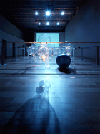
CONCEPT
Project Background
The Locker Baby project, first conceived in 2001, consists of 3 installation plans : baby play, baby love, and baby work. The first installment, baby play, was commissioned and exhibited at NTT[ICC]( InterCommunication Center ), in Tokyo in 2001. The Locker Baby project recalls Ryu MurakamI's noted novel Coin Locker Babies (1980) in which two boys abandoned at birth in one square foot metal boxes grew up haunted with the sound of human heart beats, those of their birth mothers. The updated version of locker baby proposes a fictional scenario set in year 2030. The DPT (DollyPolly Transgency) clones locker babies with genes extracted from deep sea pearls harvested off Okinawa Island . Coin lockers situated in busy Tokyo train stations are the breeding grounds for underworld test tube locker babies. The biobot locker babies are the clone generation of our scifi fantasia reality, entrusted to receive, store, transmit and negotiate human memory and emotion. Locker baby holds the key to unlock a networked inter-sphere of ME (Memory-Emotion ) data.
 |
 |
 |
installation view: Baby Play (NTT[ICC], Tokyo, 2001)
Baby Love - concept
Baby Love situates human and its baby clones in a perpetual spin of fairground teacup ride. Tea and sympathy, love and ME-motion. Love songs, uploaded by the public and transmitted via 802.11 wireless network by the public are coded as ME-data in the cloned locker babies. Revolt against mirrored self, the clone babies reprocess the networked ME-data during the joy teacup ride. By taking a teacup ride with the babies, the ME-data are retrieved, played back, shuffled, and jumbled. A gentle ride turned fast spin, the data jams and jammed, we are left to sort out the ME with the babies in the storming teacups. The crash would eventually happen. Upon the carsh when the teacups bump into each other, the clone babies exchange ME data and broadcast the remix on the web.
 |